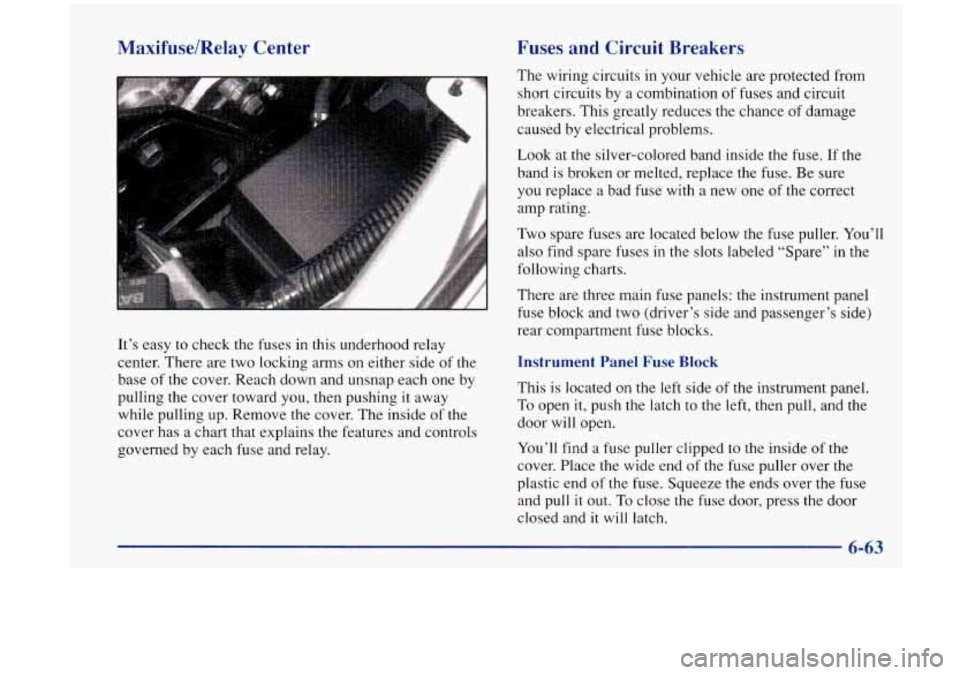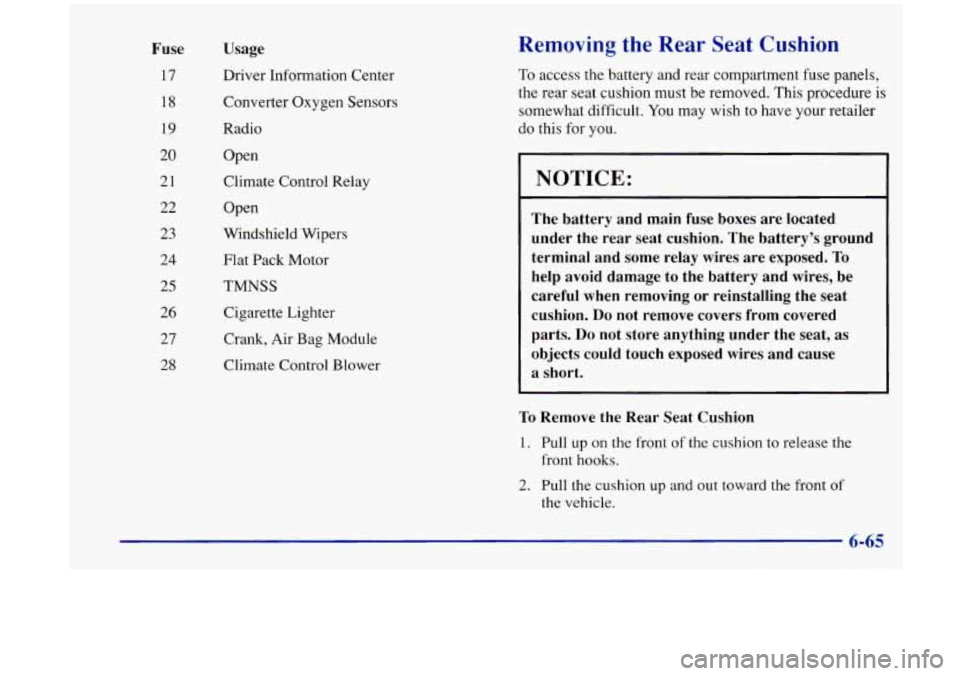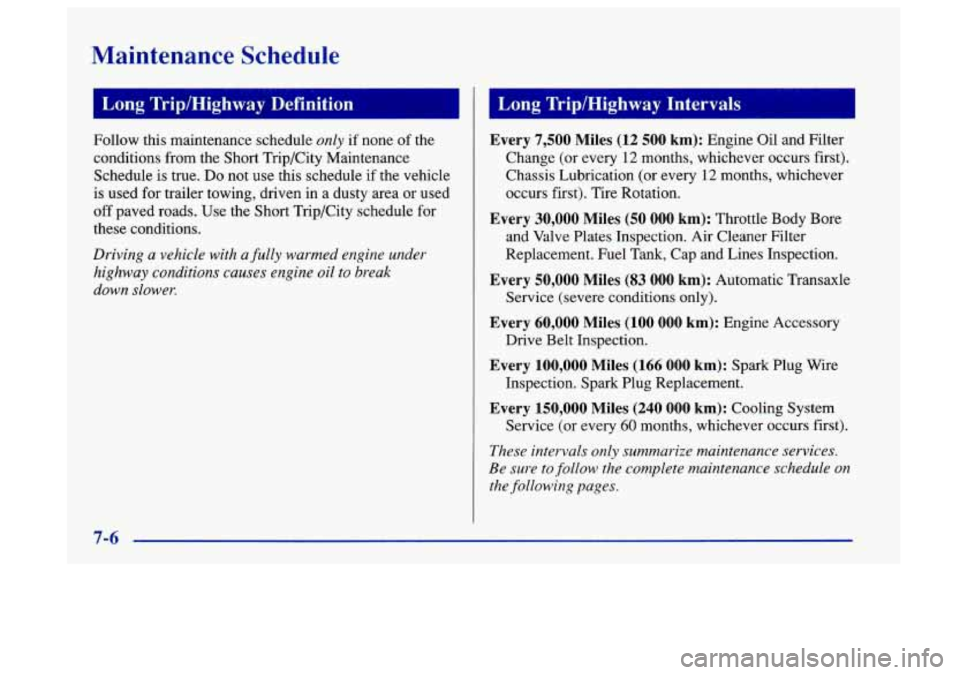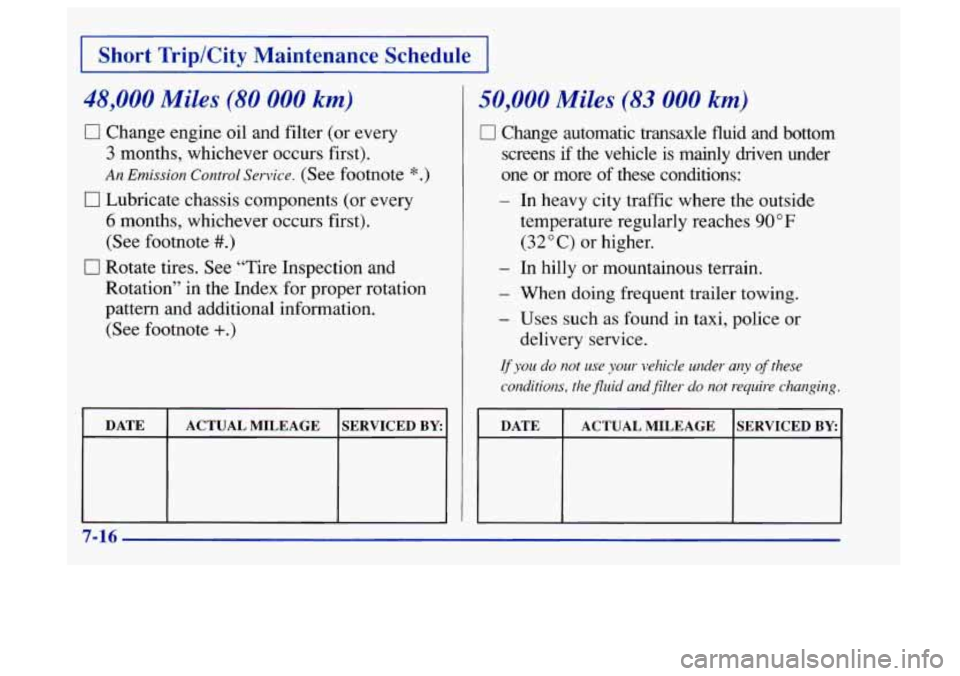tow Oldsmobile Aurora 1997 s Workshop Manual
[x] Cancel search | Manufacturer: OLDSMOBILE, Model Year: 1997, Model line: Aurora, Model: Oldsmobile Aurora 1997Pages: 404, PDF Size: 20.75 MB
Page 310 of 404

Foreign materials such as calcium chloride and other
salts, ice melting agents, road oil and tar, tree sap, bird
droppings, chemicals from industrial chimneys, etc., can
damage your vehicle’s finish if they remain
on painted
surfaces. Wash the vehicle as soon as possible. If
necessary, use non-abrasive cleaners that are marked
safe for painted surfaces to remove foreign matter. Don’t take your vehicle through an automatic
car wash
that has silicon carbide tire cleaning brushes. These
brushes can also damage the surface of these wheels.
Cleaning Tires
To clean your tires, use a stiff brush with a tire cleaner.
Exterior painted surfaces are subject to aging, weather
and chemical fallout that can take their toll over a period
of years.
You can help to keep the paint finish looking
new by keeping your Aurora garaged or covered
whenever possible.
Cleaning Aluminum or
Chrome Wheels
Keep your wheels clean using a soft clean cloth with
mild soap and water. Rinse with clean water. After
rinsing thoroughly,
dry with a soft clean towel. A wax
may then be applied.
The surface of these wheels is similar to the painted
surface
of your vehicle. Don’t use strong soaps,
chemicals, abrasive polishes, abrasive cleaners or
abrasive cleaning brushes on them because you could
damage the surface.
I NOTICE:
When applying a tire dressing always take care to
wipe off any overspray or splash from all painted
surfaces on the body or wheels of the vehicle.
Petroleum-based products may damage the
paint finish.
Sheet Metal Damage
If your vehicle is damaged and requires sheet metal
repair or replacement, make sure the body repair shop
applies anti-corrosion material to the parts repaired or
replaced to restore corrosion protection.
6-58
Page 315 of 404

Maxifuse/Relay Center
It’s easy to check the fuses in this underhood relay
center. There are two locking arms on either side
of the
base of the cover. Reach down and unsnap each one by
pulling
the cover toward you, then pushing it away
while pulling up. Remove the cover.
The inside of the
cover has a chart that explains the features and controls
governed by each fuse and relay.
Fuses and Circuit Breakers
The wiring circuits in your vehicle are protected from
short circuits
by a combination of fuses and circuit
breakers. This greatly reduces the chance of damage
caused by electrical problems.
Look at the silver-colored band inside the fuse. If the
band is broken or melted, replace the fuse. Be sure
you replace a bad fuse with a new one of the correct
amp rating.
Two spare fuses are located below the fuse puller.
You’ll
also find spare fuses in the slots labeled “Spare” in the
following charts.
There are three main fuse panels: the instrument panel
fuse block and two (driver’s side and passenger’s side)
rear compartment fuse blocks.
Instrument Panel Fuse Block
This is located on the left side of the instrument panel.
To open it, push the latch to the left, then pull, and the
door will open.
You’ll find a fuse puller clipped to the inside of the
cover. Place the wide end of the fuse puller over the
plastic end
of the fuse. Squeeze the ends over the fuse
and pull
it out. To close the fuse door, press the door
closed and it will latch.
Page 317 of 404

Fuse
17
18
19
20
21
22
23
24
25
26
27
28
Usage
Driver Information Center
Converter Oxygen Sensors
Radio
Open
Climate Control Relay
Open
Windshield Wipers
Flat Pack Motor
TMNSS Cigarette Lighter
Crank, Air Bag Module
Climate Control Blower Removing the Rear Seat Cushion
To access the battery and rear compartment fuse panels,
the rear seat cushion must be removed. This procedure is
somewhat difficult. You may wish to have your retailer
do this for you.
NOTICE:
The battery and main fuse boxes are located
under the rear seat cushion. The battery’s ground
terminal and some relay wires are exposed.
To
help avoid damage to the battery and wires, be
careful when removing or reinstalling the seat
cushion.
Do not remove covers from covered
parts.
Do not store anything under the seat, as
objects could touch exposed wires and cause
a short.
To Remove the Rear Seat Cushion
1. Pull up on the front of the cushion to release the
front
hooks.
2. Pull the cushion up and out toward the front of
the vehicle.
6-65
Page 333 of 404

Maintenance Schedule
I Short Trip/City Definition I
Follow the Short Trip/City Maintenance Schedule if any
one of these conditions is true for your vehicle:
0
0
0
0
0
Most trips are less than 5 to 10 miles (8 to 16 km).
This is particularly important when outside
temperatures are below freezing.
Most trips include extensive idling (such
as frequent
driving in stop-and-go traffic).
Most trips are through dusty areas.
You frequently tow a trailer or use a carrier on top of
your vehicle.
If the vehicle is used for delivery service, police, taxi
or other commercial application.
One of the reasons you should follow this schedule if
you operate your vehicle under any of these conditions
is that these conditions cause engine oil to break
down sooner.
Short Trip/City Intervals
Every 3,000 Miles (5 000 km): Engine Oil and Filter
Change (or
3 months, whichever occurs first).
(or
6 months, whichever occurs first). Tire Rotation.
Every 6,000 Miles (10 000 km): Chassis Lubrication
Every 30,000 Miles (50 000 km): Air Cleaner Filter
Replacement. Throttle Body Bore and Valve Plates
Inspection. Fuel Tank, Cap and Lines Inspection.
Service (severe conditions only).
Every 50,000 Miles (83 000 km): Automatic Transaxle
Every 60,000 Miles (100 000 km): Engine Accessory
Every 100,000 Miles (166 000 km): Spark Plug Wire
Every 150,000 Miles (240 000 km): Cooling System
Drive Belt
Inspection.
Inspection. Spark Plug Replacement.
Service (or every
60 months, whichever occurs first).
These intervals only summarize maintenance services.
Be sure
to follow the complete maintenance schedule on
the following pages.
Page 334 of 404

Maintenance Schedule
I Long Trip/Highway Definition I
Follow this maintenance schedule only if none of the
conditions from the Short Trip/City Maintenance
Schedule is true.
Do not use this schedule if the vehicle
is used
for trailer towing, driven in a dusty area or used
off paved roads. Use the Short Trip/City schedule for
these conditions.
Driving a vehicle with a fully warmed engine under
highway conditions causes engine oil to break
down slower.
Long Trip/Highway Intervals
1
Every 7,500 Miles (12 500 km): Engine Oil and Filter
Change (or every
12 months, whichever occurs first).
Chassis Lubrication (or every
12 months, whichever
occurs first). Tire Rotation.
Every 30,000 Miles (50 000 km): Throttle Body Bore
and Valve Plates Inspection. Air Cleaner Filter
Replacement. Fuel Tank, Cap and Lines Inspection.
Every 50,000 Miles (83 000 km): Automatic Transaxle
Every 60,000 Miles (100 000 km): Engine Accessory
Service (severe conditions
only).
Drive Belt Inspection.
Every 100,000 Miles (166 000 km): Spark Plug Wire
Every 150,000 Miles (240 000 km): Cooling System
Inspection. Spark Plug Replacement.
Service
(or every 60 months, whichever occurs first).
These intervals only summarize maintenance services.
Be sure
to follow the complete maintenance schedule on
the following pages.
Page 344 of 404

I Short Trip/City Maintenance Schedule I
48,000 Miles (80 000 km)
0 Change engine oil and filter (or every
3 months, whichever occurs first).
An Emission Control Service. (See footnote *.)
6 months, whichever occurs first).
(See footnote
#.)
0 Rotate tires. See “Tire Inspection and
Rotation” in the Index for proper rotation
pattern and additional information.
(See footnote
+.)
0 Lubricate chassis components (or every
DATE SERVICED BY ACTUAL MILEAGE
50,000 Miles (83 000 km)
0 Change automatic transaxle fluid and bottom
screens if the vehicle is mainly driven under
one or more of these conditions:
- In heavy city traffic where the outside
temperature regularly reaches
90 OF
(32 O C) or higher.
- In hilly or mountainous terrain.
- When doing frequent trailer towing.
- Uses such as found in taxi, police or
If you do not use your vehicle under any of these
conditions, the fluid aid filter do not require changing.
delivery service.
DATE SERVICED BY: ACTUAL MILEAGE
7-16
Page 355 of 404

I Short Trip/City Maintenance Schedule I
- When doing frequent trailer towing.
- Uses such as found in taxi, police or
delivery service.
If you do not use your vehicle under any of
these conditions, the fluid and filter do not
require changing.
I I I 3
DATE
SERVICED BY ACTUAL MILEAGE
150,000 Miles (240 000 km)
0 Drain, flush and refill cooling system
(or every
60 months since last service,
whchever occurs first). See “Engine
Coolant” in the Index for what to use.
Inspect hoses. Clean radiator, condenser,
pressure cap and neck. Pressure test
cooling system and pressure cap.
An Emission Control Service.
DATE SERVICED BY ACTUAL MILEAGE
7-27
Page 360 of 404

I Long TriplHighway Maintenance Schedule
..
I
45,000 Miles (75 000 km)
17 Change engine oil and filter (or every
12 months, whichever occurs first).
An Emission Control Service. (See footnote *.)
0 Lubricate chassis components (or every
12 months, whichever occurs first).
(See footnote
#.)
Rotate tires. See “Tire Inspection and
Rotation” in the Index for proper rotation
pattern and additional information.
(See footnote
+.)
DATE ACTUAL MILEAGE SERVICED BY:
50,000 Miles (83 000 km)
0 Change automatic transaxle fluid and bottom
screens
if the vehicle is mainly driven under
one or more of these conditions:
- In heavy city traffic where the outside
temperature regularly reaches
90 OF
(32 O C) or higher.
- In hilly or mountainous terrain.
- When doing frequent trailer towing.
- Uses such as found in taxi, police or
delivery service.
If you do not use your vehicle under any of these
conditions, the
fluid and filter do not require changing.
J
7-32
Page 366 of 404

~ Long-TriplHighway Maintenance Schedule 1
100,000 Miles (I 6t ued)
- When doing frequent trailer towing.
- Uses such as
found in taxi, police or
If you do not use your vehicle under any of
these conditions, the fluid and filter do not
require changing.
delivery service.
150,000 Miles (240 000 km)
0 Drain, flush and refill cooling system
(or every
60 months since last service,
whichever occurs first). See "Engine
Coolant''
in the Index for what to use.
Inspect hoses. Clean radiator, condenser,
pressure cap and neck. Pressure test
the cooling system and pressure cap.
An Emission Control Service.
DATE ACTUAL MILEAGE SERVICED BY:
7-38
Page 382 of 404

For prompt assistance, please have the following information available to give the Customer
Assistance Representative:
0 Your name, address, home and business
telephone numbers
Vehicle Identification Number (This is available
from the vehicle registration or title, or the plate at
the top left
of the instrument panel and visible
through the windshield.)
Retail facility name and location
0 Vehicle delivery date and present mileage
Nature of concern
We encourage you to call us
so we can give your inquiry
prompt attention. However, if
you wish to write
Oldsmobile, address your inquiry to:
Customer Assistance Representative Oldsmobile Central Office
920 Townsend Street
P.O. Box 30095
Lansing, MI 48909
In Canada, write to:
General Motors of Canada Limited
Customer Communication Centre, 163-005
1908 Colonel Sam Drive
Oshawa, Ontario LlH
8P7
Refer to your Warranty and Owner Assistance Information
booklet for addresses of
GM Overseas offices.
When contacting Oldsmobile, please remember that your concern will likely be resolved in the retail facility,
using
the retailer’s facilities, equipment and personnel.
That is why we suggest you follow Step One first
if you
have a concern.
Customer Assistance for Text
Telephone (TTY) Users
To assist customers who are deaf, hard of hearing, or
speech-impaired and who use Text Telephones (TTYs),
Oldsmobile has TTY equipment available
at its
Customer Assistance Center. Any TTY user
can communicate with Oldsmobile by dialing:
1-800-833-OLDS. (TTY users in Canada can dial
1-800-263-3830.)
8-4